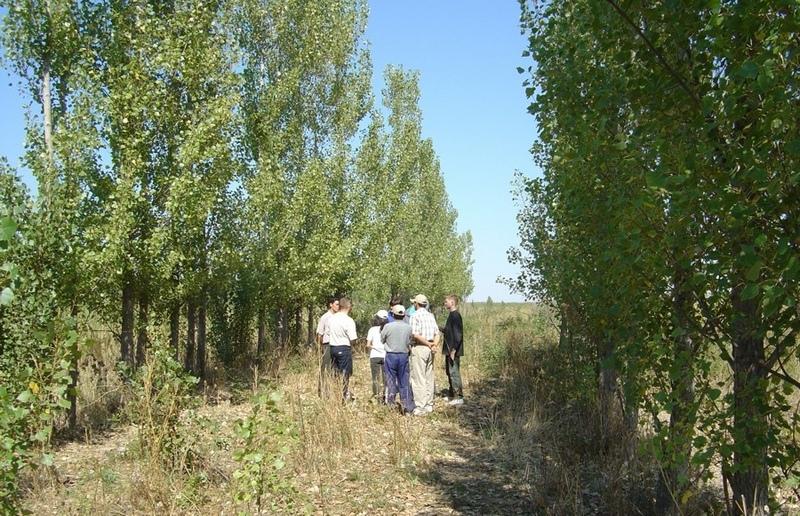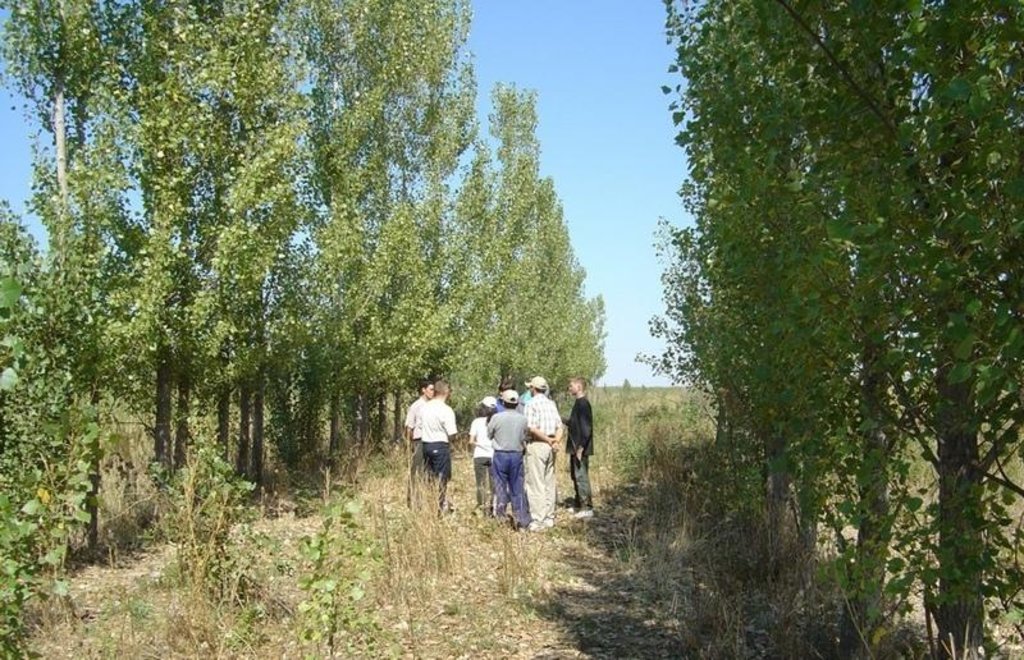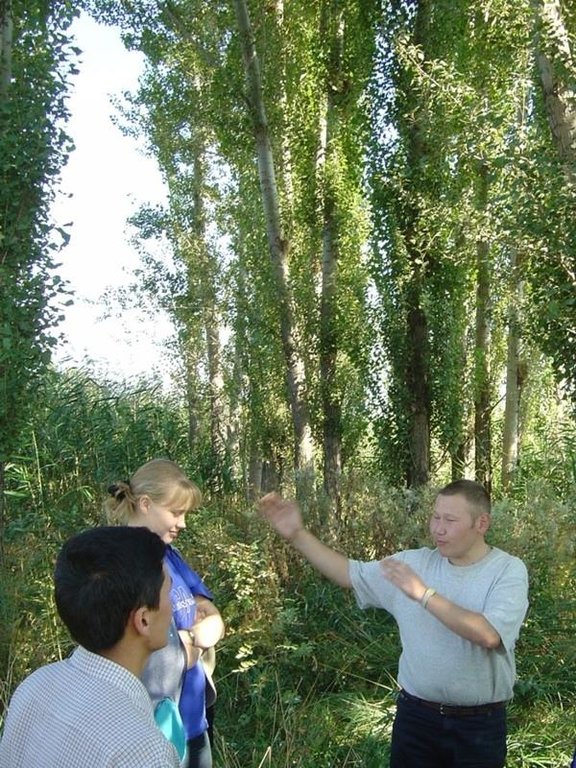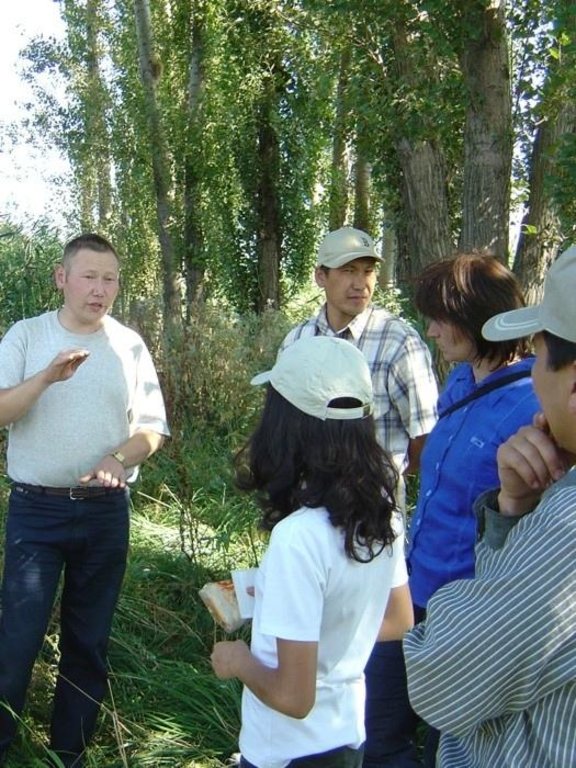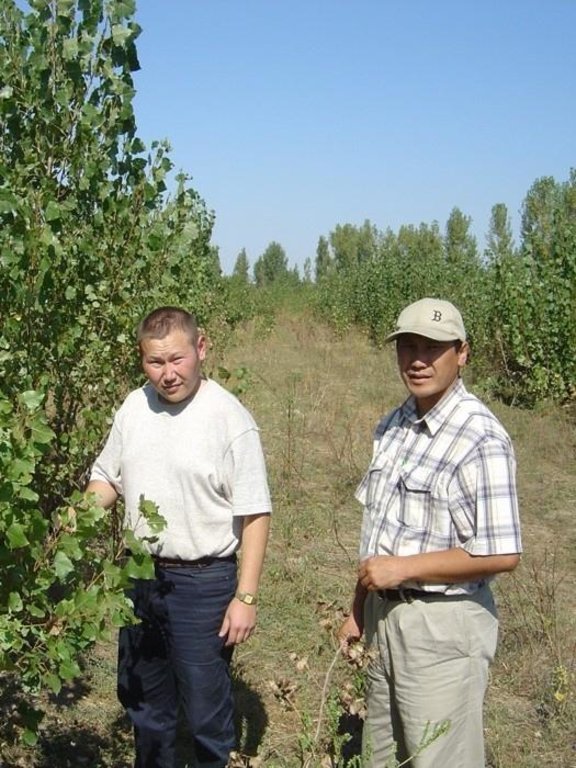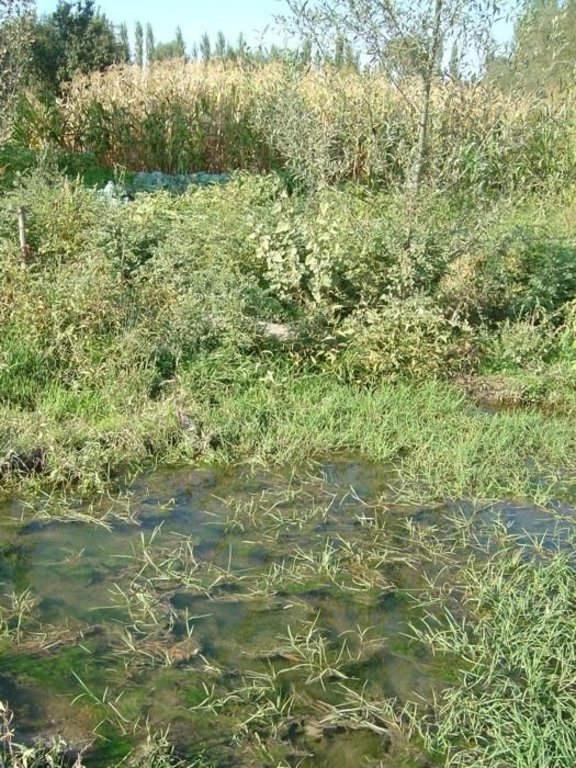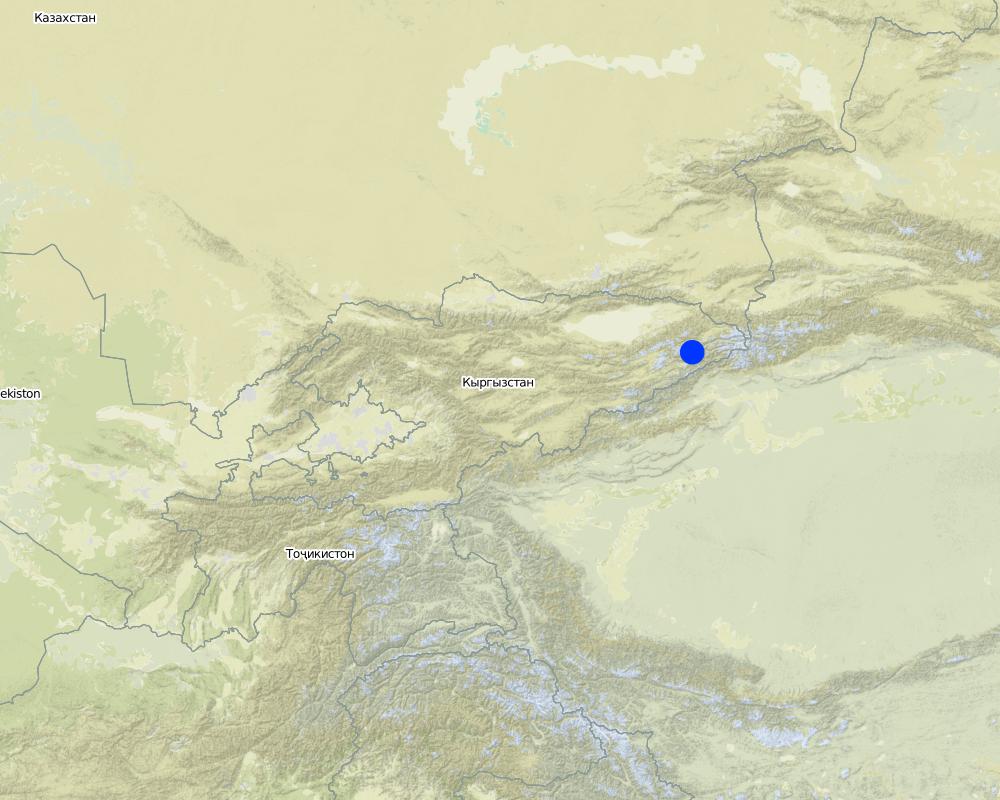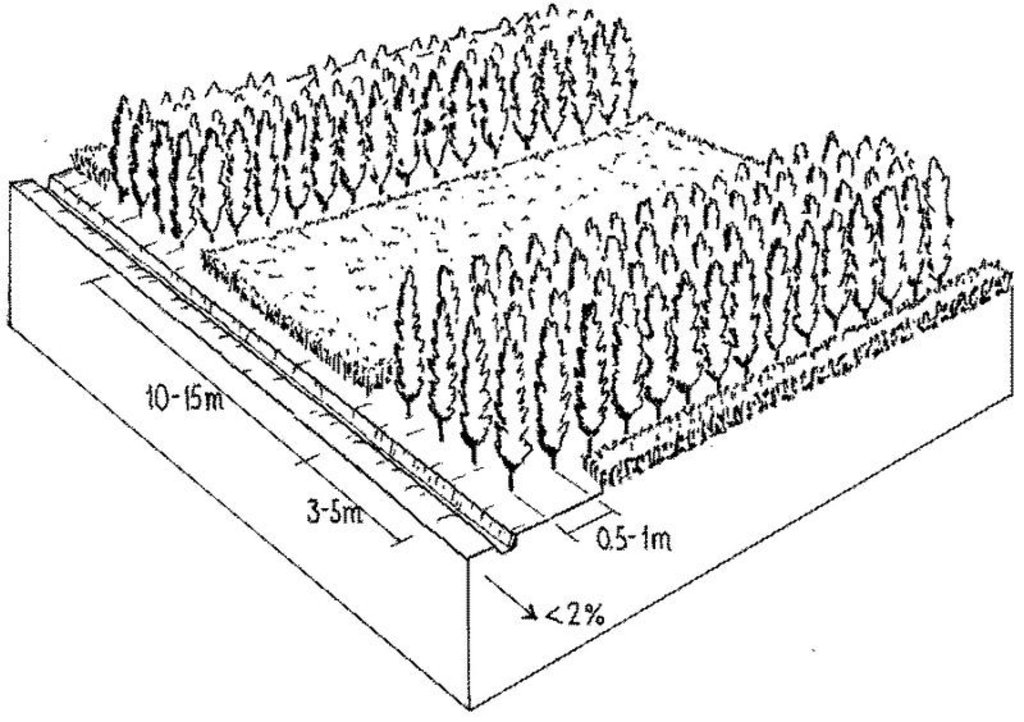Poplar trees for bio-drainage [Quirguizistão]
- Criação:
- Atualização:
- Compilador/a: Abdybek Asanaliev
- Editor: –
- Revisores: David Streiff, Deborah Niggli, Alexandra Gavilano
bio-drainage, reduce salinity, favourable microclimate for for plant growth
technologies_1098 - Quirguizistão
Veja as seções
Expandir tudo Recolher tudo1. Informação geral
1.2 Detalhes do contato das pessoas capacitadas e instituições envolvidas na avaliação e documentação da tecnologia
Especialista em GST:
Nome do projeto que facilitou a documentação/avaliação da Tecnologia (se relevante)
Book project: where the land is greener - Case Studies and Analysis of Soil and Water Conservation Initiatives Worldwide (where the land is greener)Nome da(s) instituição(ões) que facilitou(ram) a documentação/ avaliação da Tecnologia (se relevante)
Kyrgyz Agrarian University (Kyrgyz Agrarian University) - Quirguizistão1.3 Condições em relação ao uso da informação documentada através de WOCAT
O compilador e a(s) pessoa(s) capacitada(s) aceitam as condições relativas ao uso de dados documentados através do WOCAT:
Sim
2. Descrição da tecnologia de GST
2.1 Descrição curta da tecnologia
Definição da tecnologia:
Poplars planted to lower the ground water table and reduce salinity where irrigation drainage systems have broken down; lucerne cultivated between the tree lines.
2.2 Descrição detalhada da tecnologia
Descrição:
In irrigated areas of Central Asia, the drainage system introduced during soviet times has broken down due to lack of maintenance. As a result, water tables have been rising and soil salinity increasing. In the Chui Valley, which is the main crop production area in Kyrgyzstan, approximately 90% of the cultivated land is irrigated for wheat, maize, sugar beet, lucerne and vegetables. Of this, approximately one third (ca. 320,000 ha) is degraded due to loss of fertility, salinisation and waterlogging.
The individual initiative described here - poplar planting - has been applied on a degraded plain (about 400 m a.s.l.), under semi-arid conditions on a plot of 5 hectares. Though initially planted for timber, an important side effect was noted by the farmer in question. Poplar trees, well known for their tolerance to waterlogging and salinity, provide ‘bio-drainage’. Excess water is rapidly taken up by the root system and transpired through the dense foliage. Within the plantation the humidity level of the lower layers of air is increased, thus reducing the influence of the dry, hot winds. A more favourable microclimate for plant growth is thus created. Simultaneously the original purpose of planting - to obtain cheap timber and firewood - is achieved through the rapid growth of the trees: there is a severe shortage of wood locally.
The varieties used include the local Populus alba and Populus nigra as well as a hybrid from Kazakhstan, P. pyramidalis. The trees are planted in rows about 5 metres wide, separated by 10-15 metre strips planted with Medicago sativa (lucerne) and Bromus inermis (a grass), both of which are grown for hay (see technical drawing). Around 3,000 saplings are needed per hectare. The young poplars require irrigating during the first year before their roots can reach the water table. The trees are weeded and their lower branches pruned to encourage straight and fast growth. They are thinned twice before they are 14 years old: these thinnings can be sold. The poplars then remain until they are 20-25 years old and suitable for felling. The output of commercial timber of a poplar plantation is 3,000 m2 per hectare (1 m2 per mature tree). Slow-growing/sick trees, as well as pruned branches, are used as firewood - which can amount to 20-30 m3 per hectare. The cycle begins again after approximately 10 years, when new saplings are planted between the existing, thinned, lines of poplars. Desalinisation of the soil takes 10 years or a little longer, when it again becomes suitable for irrigated cereal cropping.
2.3 Fotos da tecnologia
2.5 País/região/locais onde a tecnologia foi aplicada e que estão cobertos nesta avaliação
País:
Quirguizistão
Região/Estado/Província:
Besh-Terek, Chui valley,
Especifique a difusão da tecnologia:
- Uniformemente difundida numa área
Se a Tecnologia estiver uniformemente distribuída por uma área, especifique a área coberta (em km2):
0,05
Comentários:
Total area covered by the SLM Technology is 0.05 km2.
Map
×2.7 Introdução da tecnologia
Especifique como a tecnologia foi introduzida:
- durante experiências/ pesquisa
3. Classificação da tecnologia de GST
3.1 Principal/principais finalidade(s) da tecnologia
- Reduz, previne, recupera a degradação do solo
3.2 Tipo(s) atualizado(s) de uso da terra onde a tecnologia foi aplicada
Uso do solo misturado dentro da mesma unidade de terra:
Sim
Especificar o uso misto da terra (culturas/ pastoreio/ árvores):
- Agrofloresta

Terra de cultivo
- Cultura anual
Cultivo anual - Especificar culturas:
- culturas forrageiras - alfalfa
Número de estações de cultivo por ano:
- 1
Especifique:
Longest growing period in days: 180; Longest growing period from month to month: Mar - Sep

Floresta/bosques
Tipo de árvore:
- Espécies Populus
Comentários:
Major food crop: Poplar, lucerne (alfalfa), wheat
Major land use problems (compiler’s opinion): Irrigation drainage systems have deteriorated (silted up, choked with weeds and reeds) due to lack of maintenance. This has led to a raised water table, waterlogging and increased salinity, thus seriously affecting productivity and making cultivation of some crops impossible. Farmers’ incomes have significantly reduced as a result.
Constraints of wastelands / deserts / glaciers / swamps
3.5 Grupo de GST ao qual pertence a tecnologia
- Gestão de plantação florestal
- Solo/cobertura vegetal melhorada
3.6 Medidas de GST contendo a tecnologia

Medidas agronômicas
- A1: cobertura vegetal/do solo

Medidas vegetativas
- V1: cobertura de árvores/arbustos
Comentários:
Type of agronomic measures: legume inter-planting
Type of vegetative measures: aligned: -against wind
3.7 Principais tipos de degradação da terra abordados pela tecnologia

Deteriorização química do solo
- Cn: declínio de fertilidade e teor reduzido de matéria orgânica (não causado pela erosão)
- Cs: salinização/alcalinização

Deteriorização física do solo
- Pw: estagnação hídrica
Comentários:
Secondary types of degradation addressed: Cn: fertility decline and reduced organic matter content
3.8 Redução, prevenção ou recuperação da degradação do solo
Especifique o objetivo da tecnologia em relação a degradação da terra:
- Recuperar/reabilitar solo severamente degradado
4. Especificações técnicas, implementação de atividades, entradas e custos
4.1 Desenho técnico da tecnologia
Especificações técnicas (relacionada ao desenho técnico):
Alternating strips of poplar trees for bio-drainage, and lucerne for fodder. Drainage channels (left) are spaced at 50 metres apart.
Technical knowledge required for field staff / advisors: moderate
Technical knowledge required for land users: moderate
Main technical functions: lower ground water level, decrease waterlogging & improve soil fertility, reduce risk of salinisation
Secondary technical functions: reduction in wind speed, increased air humidity & cooling effect
Aligned: -against wind
Vegetative material: T : trees / shrubs
Trees/ shrubs species: Poplars (Populus alba, Populus nigra, P.pyramidalis)
Autor:
Mats Gurtner
4.2 Informação geral em relação ao cálculo de entradas e custos
Especifique a moeda utilizada para os cálculos de custo:
- USD
4.3 Atividades de implantação
| Atividade | Periodicidade (estação do ano) | |
|---|---|---|
| 1. | Set up tree nursery one year before planting: take cuttings about | |
| 2. | Demarcate lines in field. | |
| 3. | Dig drainage trenches in the marshy area (50 cm deep, 50 cm wide, | (end of summer, early autumn) |
| 4. | Plough where seedlings of the poplars are to be planted. | |
| 5. | Transplant tree seedlings from the nursery to the field . | in spring |
| 6. | Irrigate the seedlings by furrow for one year. | |
| 7. | Protect the area from animals. | |
| 8. | Plant lucerne . | in first year after planting of poplars |
4.4 Custos e entradas necessárias para a implantação
| Especifique a entrada | Unidade | Quantidade | Custos por unidade | Custos totais por entrada | % dos custos arcados pelos usuários da terra | |
|---|---|---|---|---|---|---|
| Mão-de-obra | All the Labour | ha | 1,0 | 350,0 | 350,0 | 100,0 |
| Mão-de-obra | Machine use | ha | 1,0 | 100,0 | 100,0 | 100,0 |
| Mão-de-obra | Animal traction | ha | 1,0 | 5,0 | 5,0 | 100,0 |
| Equipamento | Tools | ha | 1,0 | 15,0 | 15,0 | |
| Material vegetal | Seeds | ha | 1,0 | 20,0 | 20,0 | 1,0 |
| Material vegetal | Seedlings | ha | 1,0 | 350,0 | 350,0 | 1,0 |
| Material vegetal | Nursery | ha | 1,0 | 80,0 | 80,0 | 1,0 |
| Custos totais para a implantação da tecnologia | 920,0 | |||||
| Custos totais para o estabelecimento da Tecnologia em USD | 920,0 | |||||
Comentários:
Duration of establishment phase: 24 month(s)
4.5 Atividades recorrentes/manutenção
| Atividade | Periodicidade/frequência | |
|---|---|---|
| 1. | Prune lower branches of the trees to encourage tall and straight | |
| 2. | Continue protection of the plot (because of lucerne). | |
| 3. | Cut lucerne for hay . | /4 times per year |
| 4. | Weed control (main weeds are Chenopodium album, |
4.6 Custos e entradas necessárias pata a manutenção/atividades recorrentes (por ano)
| Especifique a entrada | Unidade | Quantidade | Custos por unidade | Custos totais por entrada | % dos custos arcados pelos usuários da terra | |
|---|---|---|---|---|---|---|
| Mão-de-obra | All the labour | ha | 1,0 | 25,0 | 25,0 | 100,0 |
| Equipamento | Machine use | ha | 1,0 | 5,0 | 5,0 | 100,0 |
| Custos totais para a manutenção da tecnologia | 30,0 | |||||
| Custos totais de manutenção da Tecnologia em USD | 30,0 | |||||
Comentários:
Machinery/ tools: shovel, axe, saw
Labour for establishment and maintenance are provided by the farmer and his family. After 10–15 years trees are
thinned for timber and the cycle begins again – with reduced establishment costs: new saplings are planted between the
existing, thinned, lines of poplars. On two sides the plot is protected by a drainage ditch and a concrete canal protect the plot respectively. Furthermore, there is an agreement with the neighbours not to let the animals graze the lucerne. However after the last cut of lucerne animals are allowed to graze the plot.
5. Ambiente natural e humano
5.1 Clima
Precipitação pluviométrica anual
- <250 mm
- 251-500 mm
- 501-750 mm
- 751-1.000 mm
- 1.001-1.500 mm
- 1.501-2.000 mm
- 2.001-3.000 mm
- 3.001-4.000 mm
- > 4.000 mm
Zona agroclimática
- Semiárido
5.2 Topografia
Declividade média:
- Plano (0-2%)
- Suave ondulado (3-5%)
- Ondulado (6-10%)
- Moderadamente ondulado (11-15%)
- Forte ondulado (16-30%)
- Montanhoso (31-60%)
- Escarpado (>60%)
Formas de relevo:
- Planalto/planície
- Cumes
- Encosta de serra
- Encosta de morro
- Sopés
- Fundos de vale
Zona de altitude:
- 0-100 m s.n.m.
- 101-500 m s.n.m.
- 501-1.000 m s.n.m.
- 1.001-1.500 m s.n.m.
- 1.501-2.000 m s.n.m.
- 2.001-2.500 m s.n.m.
- 2.501-3.000 m s.n.m.
- 3.001-4.000 m s.n.m.
- > 4.000 m s.n.m.
5.3 Solos
Profundidade do solo em média:
- Muito raso (0-20 cm)
- Raso (21-50 cm)
- Moderadamente profundo (51-80 cm)
- Profundo (81-120 cm)
- Muito profundo (>120 cm)
Textura do solo (solo superficial):
- Médio (limoso, siltoso)
Matéria orgânica do solo superficial:
- Médio (1-3%)
Caso disponível anexe a descrição completa do solo ou especifique as informações disponíveis, p. ex. tipo de solo, PH/acidez do solo, nitrogênio, capacidade de troca catiônica, salinidade, etc.
Soil fertility is very low - low
Soil drainage / infiltration is poor
5.6 Características dos usuários da terra que utilizam a tecnologia
Orientação de mercado do sistema de produção:
- Subsistência (autoabastecimento)
- Comercial/mercado
Rendimento não agrícola:
- 10-50% de toda renda
Indique outras características relevantes dos usuários da terra:
Off-farm income specification: this individual is an employee of the regional agricultural department and has a small business
Market orientation of production system: Thinned poplar saplings, timber and firewood from prunings for market
5.7 Área média de terrenos utilizados pelos usuários de terrenos que aplicam a Tecnologia
- < 0,5 ha
- 0,5-1 ha
- 1-2 ha
- 2-5 ha
- 5-15 ha
- 15-50 ha
- 50-100 ha
- 100-500 ha
- 500-1.000 ha
- 1.000-10.000 ha
- > 10.000 ha
5.8 Propriedade de terra, direitos de uso da terra e de uso da água
Propriedade da terra:
- Indivíduo, intitulado
Direitos do uso da terra:
- Indivíduo
6. Impactos e declarações finais
6.1 Impactos no local mostrados pela tecnologia
Impactos socioeconômicos
Produção
Produção de forragens
Comentários/especificar:
Lucerne between tree lines
Qualidade da forragem
Comentários/especificar:
Lucerne between tree lines
Produção de madeira
Renda e custos
Rendimento agrícola
Carga de trabalho
Outros impactos socioeconômicos
input contstraints
Comentários/especificar:
Not all the farmers have enough resources for introduction of this technology (equipment,
main benefit
Comentários/especificar:
However, short-term benefit from lucerne as fodder and from firewood through pruning
Impactos socioculturais
Conhecimento de GST/ degradação da terra
Impactos ecológicos
Ciclo hídrico/escoamento
Drenagem de excesso de água
Solo
Umidade do solo
Clima e redução de riscos de desastre
Risco de incêndio
Velocidade do vento
Outros impactos ecológicos
soil fertility
Comentários/especificar:
Due to lucerne: 100–130 kg of N
biodiversity
6.2 Impactos externos mostrados pela tecnologia
Sedimentos transportados pelo vento
General drop of water table
6.4 Análise do custo-benefício
Como os benefícios se comparam aos custos de implantação (do ponto de vista dos usuários da terra)?
Retornos a curto prazo:
negativo
Retornos a longo prazo:
muito positivo
Como os benefícios se comparam aos custos recorrentes/de manutenção(do ponto de vista dos usuários da terra)?
Retornos a curto prazo:
positivo
Retornos a longo prazo:
muito positivo
6.5 Adoção da tecnologia
- casos isolados/experimental
Se disponível, determine a quantidade (número de unidades familiares e/ou área abordada):
1 household
De todos aqueles que adotaram a Tecnologia, quantos o fizeram espontaneamente, ou seja, sem receber nenhum incentivo/ pagamento material?
- 0-10%
Comentários:
There is a little trend towards spontaneous adoption of the Technology
Comments on adoption trend: A single farmer has developed this technology. It should be possible to spread the technology among other farmers but financial support (eg interest-free credit) will need to be provided. A recent assessment has showed that there is growing interest in the system by farmers in the region. Additionally, in the lower Yanvan Valley of Tajikistan, a similar bio-drainage system has been described - using poplars and mulberry trees. In that situation wheat is planted in association with the trees.
6.7 Pontos fortes/vantagens/oportunidades da tecnologia
| Pontos fortes/vantagens/oportunidades na visão do compilador ou de outra pessoa capacitada |
|---|
|
Positive ecological effect: salinity and area of marshy land can be reduced and waterlogged soils reclaimed How can they be sustained / enhanced? Awareness raising and training of farmers to show the effect of poplar trees on reduction of waterlogging and salinisation. |
|
Rapid benefit through the production of lucerne and grass. Long-term production of valuable firewood and timber (both are in short supply) How can they be sustained / enhanced? Show the economic benefits of additional lucerne production and timber and firewood; demonstrate marketing opportunities. |
6.8 Pontos fracos, desvantagens/riscos da tecnologia e formas de superá-los
| Pontos fracos/vantagens/riscos na visão do compilador ou de outra pessoa capacitada | Como eles podem ser superados? |
|---|---|
| The implementation of the technology is not possible for all land users due to input and labour constraints |
Financial support, better organisation/ share of equipment. |
| Major benefit from timber production comes only after 25 years |
Create awareness about additional short-term benefits, especially firewood and fodder, as well as the long-term effects and the sustainability of the system. |
|
Cannot be replicated by all farmers in the valley at the same density as the market for trees (timber, firewood) will be saturated, and trees can never completely take the place of irrigated food crops: nevertheless the benefits will extend to those growers through the drainage function of the poplars |
A new overall production system will have to be worked out for the region. |
|
The case reported here works in its current design because of its isolated ‘island effect’: if more farmer grew poplar, the same bio-drainage effect could be achieved over the whole valley at a lower density of trees per unit area, implying a larger proportion of cultivable land. |
7. Referências e links
7.1 Métodos/fontes de informação
7.2 Referências às publicações disponíveis
Título, autor, ano, ISBN:
Budaychiev D (2002) The prospects for hybrid poplar forest plantations. Resolving problems and the strategy of reformingagrarian science. News of Kyrgyz Agrarian Academy Vol. 2, Issue 3, 4.1 Bishkek
Links e módulos
Expandir tudo Recolher tudoLinks
Não há links
Módulos
Não há módulos


